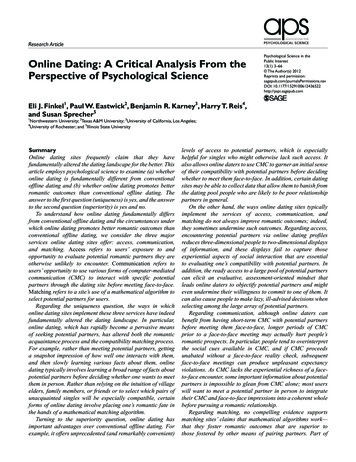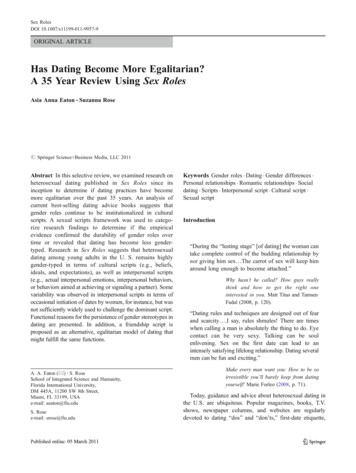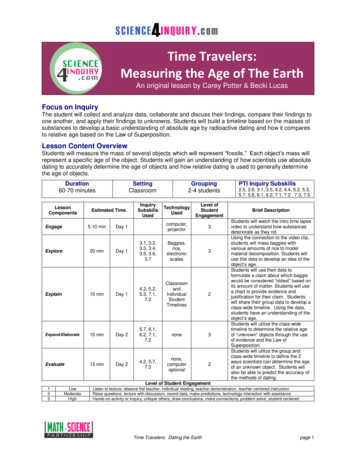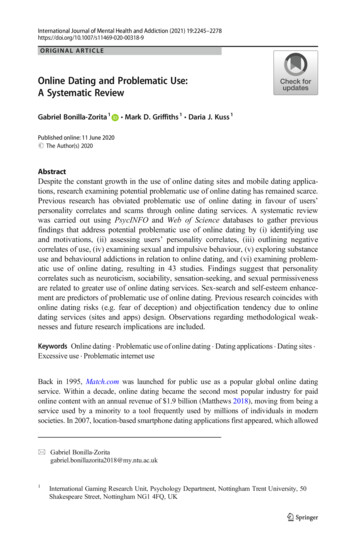
Transcription
ASTRONOMICAL DATING OF EDVARD MUNCH’SSUMMER SKY PAINTINGSThesis Supervisor:Donald W. Olson, Ph.D.Department of PhysicsSecond Reader:Heather C. Galloway, Ph.D.Department of PhysicsApproved:Heather C. Galloway, Ph.D.Director of the University Honors Program
ASTRONOMICAL DATING OF EDVARD MUNCH’SSUMMER SKY PAINTINGSHONORS THESISPresented to the Honors Committee ofTexas State University-San Marcosin Partial Fulfillment ofthe Requirementsfor Graduation in the University Honors ProgrambyAva Glenn PopeSan Marcos, TexasMay 2010
TABLE OF CONTENTSAbstract .Page 02Skies of Edvard Munch. Page 03Starry Night Image .Page 05The Storm Image .Page 06Sunrise in Åsgårdstrand Image . Page 07Questions to be Answered:Munch’s Visit to ÅsgårdstrandVenus in Starry Night?Moon in Starry Night?Red Shed in Starry Night?Page 08Page 09Page 10Page 11Finding the Answers:Trip to NorwayFlagpoleThe Red ShedWas Venus Visible in 1893?Starry Night Evening StarThe Bright “Star” in Starry NightThe StormSunrise in ÅsgårdstrandPage 11Page 14Page 15Page 17Page 18Page 21Page 23Page 27Conclusions and Acknowledgements . . .Page 31Notes . . . .Page 32Appendix . . .Page 35
ABSTRACTNorwegian painter Edvard Munch, most famous for The Scream, created manyspectacular works depicting the skies of Norway.Our Texas State group usedastronomical methods to analyze three of these paintings: Starry Night, The Storm, andSunrise in Åsgårdstrand. Astronomical dating of these paintings has some importancebecause the precise days when Munch visited Åsgårdstrand are unknown. Our researchgroup traveled to Norway in August 2008 to find the locations from which Munchpainted these three works.We then used astronomical calculations, topographicalanalyses, historical photographs, and weather records to determine the precise dates andtimes for the scenes depicted in these paintings.
3THE SKIES OF EDVARD MUNCHProfessor Donald Olson’s Texas State University group has long had an interest in theway Edvard Munch portrayed the sky. He linked the blood-red sky of The Scream to thecloud of volcanic aerosols and other debris that spread worldwide following the eruptionof Krakatoa. As part of his research, the group traveled to Norway and found the exactlocation depicted in The Scream.They verified that the artist was facing to thesouthwest, exactly the direction where the Krakatoa twilights appeared when at theirmost spectacular during the winter following the eruption.1On that same trip Dr. Olson’s group found the site of Munch’s Girls on the Pier inÅsgårdstrand. They determined the artist’s direction of view and showed that the yellowdisk in the sky of this painting was setting in the southwest and therefore must be asummer full Moon – not the Sun, as some had claimed.2As a starting point for a similar analysis of the Getty Center’s Starry Night (Fig. 1), weconsulted biographies of Munch, exhibition catalogues, and a detailed year-by-yearMunch chronology, which date this painting to 1893.3,4 We were intrigued to see that thelist of 1893 works includes two other Åsgårdstrand paintings with astronomical content.In The Storm (Fig. 2), a bright star shines in the stormy twilight sky above Åsgårdstrand’s
4Grand Hotel. Sunrise in Åsgårdstrand (Fig. 3) features the Sun just above the horizon,with a prominent glitter path stretching across the Oslo fjord.Astronomical dating of these three paintings has some importance because the precisedays when Munch visited Åsgårdstrand during 1893 are unknown. Some authors evenquestion whether the artist traveled there at all during that year and imply that he musthave created these works from memories of previous visits to the resort.
5Figure 1: Edvard Munch, Starry Night, 1893oil on canvas, 135.6 x 140 cmThe J. Paul Getty Museum, Los Angeles 2009 The Munch Museum / The Munch‐Ellingsen Group / Artists RightsSociety (ARS), New York
6Figure 2: Edvard Munch, The Storm, 1893oil on canvas, 92 x 131 cmMuseum of Modern Art, New York 2009 The Munch Museum / The Munch‐Ellingsen Group / Artists RightsSociety (ARS), New York
7Figure 3: Edvard Munch, Sunrise in Åsgårdstrand, ca. 1893oil on canvas, 65 x 89 cmprivate collection 2009 The Munch Museum / The Munch‐Ellingsen Group / Artists RightsSociety (ARS), New York
8MUNCH’S VISIT TO ÅSGÅRDSTRAND IN 1893We checked two of the most detailed chronologies of Munch’s life, and neither of thesemakes any mention of a visit to Åsgårdstrand in 1893.5,6Author Ketil Bjørnstad goes further and explicitly states for the year 1893 that Munchwas not on the scene in Åsgårdstrand:During the summer Munch does not go to Åsgårdstrand. Instead, he remains inGermany, paints landscapes with deeply atmospheric, smouldering colour, paints StarryNight, Moonlight and The Storm.7A recent biography by Sue Prideaux discusses Munch’s stay in Germany in 1893 andlikewise concludes:Summer came, and Munch had neither the money nor the inclination to go to Norway.8But these biographies and chronologies are incomplete. Our research turned up a firstperson account that was apparently overlooked by these authors. Jens Thiis, a long-timedirector of the National Gallery in Oslo, visited Åsgårdstrand in 1893 with severalfriends, including Edvard Munch and the poet Helge Rode. Thiis wrote:I happened to meet Helge again in Åsgårdstrand. It was his friend Edvard Munch whohad invited him there One day in August, when we were sitting together on the hotelveranda, I had the desire to sketch Helge Rode .9This drawing, seen in Fig. 4, bears the date of August 17, 1893, handwritten by Thiis inthe corner.Figure 4: Sketch of Helge Rode, byJens Thiis, 17 August 1893Figure 5: Detail of upper rightcorner of Thiis’ Sketch,“Åsgårdstrand, 17.8.93. J.T.”
9Because this account definitely places Munch in Åsgårdstrand, where he could beinspired by the Norwegian skies, we realized that we could possibly identify the celestialobjects in Munch’s paintings and determine dates for these works.VENUS IN STARRY NIGHT ?Figure 6: Starry Night, 1893In the articles and books that we consulted, the art historians who comment on the sky ofStarry Night all agree that Munch included the planet Venus.The Getty sponsored a book devoted entirely to an analysis of Starry Night. The author,art historian Louise Lippincott, asserts that:The pink “star” on the horizon in Starry Night is actually the planet Venus . 10Lippincott also refers to the “appearance of Venus” in the painting as “the red star on itshorizon.” 10
10Arne Eggum, former chief curator of the Munch Museum, was apparently the first tomake this Venus identification. Lippincott acknowledged that she was “deeply indebtedto A. Eggum for pointing out the star symbolism in Starry Night during his visit toMalibu .” 10 Eggum explained his reasoning:The first title Munch gave the painting Starry Night was Evening Star. As we know, theevening star is the planet Venus .11Later authors adopted the planetary identification made by Eggum and Lippincott. Forexample, Marit Lande asserts that the “light on the horizon is the reflection of the planetVenus .” 12Dieter Buchhart states that this painting includes “the bright evening star and itsprominent swath of light the planet of Venus .” 13These descriptions are somewhat confusing – some seem to be referring to the red lighton the horizon and others to the bright object up in the sky – but all of these art historiansagree that Munch’s Starry Night includes Venus.MOON IN STARRY NIGHT ?Louise Lippincott provides an astronomical explanation for the vertical white columnvisible in the garden:The view depicted in Starry Night looks down from the Grand Hotel window and acrossthis enclosed private garden. The great linden trees form a mound silhouetted against thenight sky, and their bulky shape is pierced by a dot and a streak of light from the moonhidden behind them.14She argues that her lunar theory is reasonable: Munch already had developed the dot and streak as a way of representing a lightsource and its reflection; it seems plausible to identify the motif in the Getty Museum’sStarry Night as the moon and its reflection seen through the trees.15
11RED SHED IN STARRY NIGHT?Figure 7: Contrast‐enhanced image of Starry Night; a smallred roofed building may be seen through the linden trees.Regarding the “small red house” seen inside the silhouette of the trees, Lippincott assertsthatÅsgårdstrand’s topography does not explain Starry Night’s most enigmatic element,however: the small red house standing near the great lindens, to the right of the streak ofmoonlight. No such building seems ever to have existed at the foot of theKiosterudgarden or anywhere in its immediate vicinity. Nor is it clear in the paintingexactly where the house is situated. Is it in front of the trees, or does one glimpse itthrough the foliage? 14To check these planetary, lunar, and topographical identifications, we wanted to carry outour own astronomical analysis.TRIP TO NORWAYAccordingly, our Texas State group traveled to Åsgårdstrand during August 2008. ForStarry Night and also for The Storm and Sunrise in Åsgårdstrand, we hoped to answerseveral questions: Where was Munch standing? Which way was he was facing andtherefore which part of the sky did he depict? Could we determine the dates and times?Could we identify the celestial objects in these works?
12We began by making a topographic survey of the town, using surveyor’s chains andtransit to measure distances and angles.Figure 8: Ava Pope, Joe Herbert,and Donald Olson surveying scenesof Starry Night and The StormFigure 9: Ava Pope and Joe Herbertdetermining exact position of tree inThe StormNext, Åsgårdstrand resident Knut Christian Henriksen kindly shared his immense localhistory collection, including hundreds of photographs showing Åsgårdstrand as itappeared in Munch’s time.Figure 10: Don Olson, KnutHenriksen, and Ava Pope standing infront of Knut’s shop, Fru Fadum
13By studying the historical photographs, we could see that many of the town’s buildingsfrom 1893 are still standing, and we could see where changes had occurred.Figure 11: Comparison of modern hotel to the Grand Hotel as it was in Munch’s day. Yellowarrow denotes the approximate view of the Starry Night scene as seen from the Grand HotelThe white fence visible in Munch’s Starry Night is easy to find today, and the originalgroup of linden trees is still standing in the garden of the Kiøsterud estate. To obtain theview for Starry Night, Munch must have been somewhere in the nearby Grand Hotel.A complication is that the hotel burned down in 1930 and then was rebuilt. We used thehistorical photographs, along with our own topographic survey, to determine the preciselocation of the original hotel. The southeast corner of the modern hotel is now somewhatfarther from the Kiøsterud estate (by about 10 feet) and much closer to the fjord (by about30 feet).
14We allowed for this in our calculations, using a 3-dimensional computer model tosimulate placing Munch on the veranda, on the balcony, and in the windows of theoriginal hotel. We found that we could reproduce the view of Starry Night only fromnear the center of the upper floor of the old hotel.FLAGPOLELouise Lippincott argues that Starry Night’s vertical white column with the round dot onthe top is “the moon and its reflection seen through the trees.”15 With assistance fromKnut Christian Henriksen’s resources, we can offer a different explanation.It is true that Munch depicted summer full Moons and their glitter paths in the fjord indozens of other works. But glitter paths are reflections in the water and cannot extend uphigher than the horizon. In Munch’s other works showing glitter paths, the columns oflight stop at the horizon. The vertical white column in Starry Night extends well abovethe horizon and cannot be a glitter path.Figure 12: Example of Munch’s glitter paths (notethat the light from the reflection of the moonclearly ends where the water meets the horizon)Figure 13: Detail of “Moon”in Starry NightMore than twenty historical photographs, taken from almost all possible directions, showa flagpole with a round ball at the top standing in the Kiøsterud garden. The flagpole nolonger exists, but our computer model shows that it stood exactly where Munch painted itand had the correct height (about 45 feet) relative to the group of linden trees.
15Figures 14 & 15: Historical photographsfrom Munch’s time. The flagpole stands inthe yard of the Kiøsterud House just as itappears in Starry NightFigure 16: Ava Pope, Bob Newton,and Joseph Herbert standing in theKiøsterud yard at the location ofthe base of the flagpoleWe discovered a depression in the grass where the flagpole’s base had been. Thedepression can be found by starting at the corner of the white fence, walking uphill 20feet along the fence that runs directly away from the water, and then walking 37 feet intothe garden directly away from that fence.16The hypothetical “Moon” and reflection in Starry Night turns out to be a flagpole.The Red ShedTo resolve the dilemma posed by Lippincott regarding the existence of a red shed nearthe large group of linden trees in Munch’s painting we looked at many vintageÅsgårdstrand photographs provided by Knut Henriksen. A small shed outside the gardenfence, in exactly the position to be glimpsed through the trees from Munch’s location in
16the Grand Hotel, appears in ten of these pictures. The historic photographs are blackand-white, but we also recognized the same shed depicted with a red roof in two Munchpaintings, one at the Wadsworth Athenaeum and another at the Musée d’Orsay.Figure 17: Detail of Åsgårdstrand, c. 1904;showing the red roof of a shed in front ofthe Kiøsterud estate. (WadsworthAthenaeum)Figure 18: Summer Night inÅsgårdstrand. A red roofed shed maybe seen just beyond the group of lindentrees. (Musée d’Orsay)Figure 19: Historical photograph showing a shed that Munch could haveseen through the group of trees from the Grand HotelThe “enigmatic” red shed did exist in the location in which it was portrayed by Munch.What about Venus? Did Munch see Venus during the summer of 1893?
17WAS VENUS VISIBLE IN 1893?During our visit to Åsgårdstrand we took photographs from the hotel by day, duringevening and morning twilight, and at night. We verified that Munch’s direction of viewfor Starry Night was generally to the east. The stars on the left side of the painting wouldlie somewhat north of east, while the trees on the right side are south of east.Our computer calculations show that Venus was never visible at or above the easternhorizon during morning twilight or at sunrise on any date in the spring or summer of1893. At sunset and in evening twilight, Venus was to the west of the hotel (the sideaway from the fjord), and the planet was never higher than 5 above the geometrichorizon at sunset. A steep hill behind the hotel rises with a slope that we measured to be8 . This hill would have blocked the view of Venus at sunset.Figure 20: Computer simulation of the sky of Åsgårdstrand in the summer of 1893Therefore Munch could not have seen Venus from the Åsgårdstrand Grand Hotel whetherfrom the front or back of the hotel, whether looking east toward the fjord or west towardthe hill behind the hotel, whether at morning or evening twilight, on any date in thespring or summer of 1893.17
18But a very bright “star” is clearly visible in Starry Night. What did Munch see? The blueskyglow of Starry Night suggests a Norwegian twilight. Is this morning twilight orevening twilight?STARRY NIGHT EVENING STARThe composition now called Starry Night was exhibited by Edvard Munch in his lifetimewith a variety of titles. According to Arne Eggum and other experts at the MunchMuseum, the alternate titles used for this work include The Stars, Evening Star, Night,Starry Heavens, and finally Starry Night.18 We realized that the title Evening Starprovides an important astronomical clue, telling us that the bright “star” was observedbetween sunset and midnight.But like so much else about Starry Night, even this use of the title Evening Star is hotlydisputed by some art historians. Several scholars identify the title Evening Star with acomposition now known as The Voice, which shows a woman standing in a forest alongthe coastline near Åsgårdstrand, with a yellow glitter path of moonlight reflecting in thefjord.Figure 21: The Voice, c. 1896, oil on canvasThis title dispute is considered especially significant because Evening Star (whateverpainting it was) was shown at Berlin in 1902 in the important position as painting #1 in
19the first complete exhibition of the Frieze of Life, a group of paintings considered themajor work of Munch’s artistic career. Likewise, the catalogue for an exhibition atOslo’s Diorama Hall in 1904 lists Evening Star as painting #1 in the group called Frieze(Modern Life of the Soul).Munch biographer Sue Prideaux discusses an early exhibition and makes the judgment:The first big question of identity concerns whether Evening Star in the catalogue, wasStarry Night or The Voice. I have come down on the side of The Voice 19The catalogue for a recent major Munch exhibition at the Museum of Modern Art comesto the same conclusion.20With help from librarians at Texas State University, the National Library of Norway, andthe Munch Museum Library, we located two primary sources that help to resolve this titlecontroversy.A newspaper critic from the Norwegian paper, Morgenbladet, gave the followingeyewitness description of a Munch exhibition in Oslo:And turning to his exhibition in the Diorama Hall, I want people to focus their attentionon number 1 in the catalogue !"#Evening Star.”What in the world should prevent people from understanding that this is abeautiful picture? The poetry of the summer night, the great tree standing thereslumbering in the garden, the fence shining white down towards the sea and the eveningstar shimmering up in a deep blue sky.21Figure 22: Excerpt from Morgenbladet, November 6, 1904. Underlined in blue arereferences to the title Evening Star, the great tree, and the white fence of the Kiøsterudestate.
20These details leave no doubt that the writer was describing the painting now known asStarry Night.As further confirmation, the Munch Museum has a series of photographs taken at theCommeter Gallery in Hamburg, Germany. Painting #62 in Figure 23 definitely showsStarry Night, and an accompanying list in Munch’s handwriting includes the title “62 –Abendstern” (German for “Evening Star”).Figure 23: Number 62 is the Wuppertal Museum’s Starry Night painted by Munch c. 1893.Figure 24: Entry number 62 (in Munch’s Handwriting) corresponds to the image in Fig. 23.Therefore, despite the contrary claims by some authors, this evidence demonstrates thatMunch did use Evening Star as an early title for Starry Night.
21THE BRIGHT “STAR” IN STARRY NIGHTDuring summer evenings in 1893 did any especially brilliant celestial body shine in theeastern sky over the Oslofjord?Computer calculations provided the answer: the planet Jupiter, dazzling at apparentmagnitude – 2.4 and by far the brightest object visible to an observer looking out fromÅsgårdstrand’s Grand Hotel.Above the bright object in the painting is a distinctive asterism that we recognized as thePleiades. Computer simulations show that the Pleiades star cluster was in fact locatedjust above Jupiter as the planet rose into the evening sky in 1893.Figure 25: Comparison of computer model with painting. Similarities support theidea that Munch correctly represented the late summer sky of 1893.
22Jupiter appears in the painting somewhat north of east, but the lack of topographiclandmarks along the coastline makes it difficult to assign a precise azimuth. Becauselong glitter paths like those seen in the painting occur only for celestial objects near thehorizon, Munch must have observed Jupiter at a low altitude, not long after the planetrose.The scene cannot be from the early part of the summer because, before July 9, Jupiterrose after midnight and would not reasonably be called an “evening star” by Munch.22 Apostcard in the Munch Museum archives proves that Munch had left Åsgårdstrand andwas receiving mail at Nordstrand by September 24, 1893. The view in Starry Night mustcorrespond to a date between July 9 and September 24.Figure 26: Image of postcard to Munch indicating that he had left Åsgårdstrand by 24September 1893.Determining a more precise date astronomically is difficult, because Jupiter’s positionamong the background stars remains nearly the same for many consecutive nights. Wetherefore consulted weather records of the Norwegian Meteorological Institute. Rain andovercast skies were common, and most nights could be ruled out as a match for thepainting. We found two especially clear nights.
23Describing the night of August 16-17, 1893, the local Åsgårdstrand paper recorded thatthe clouds present near sunset quickly disappeared and:Until late in the night the heavens were clear with twinkling stars.23The night of August 23-24, 1893, was likewise cloudless.We conclude that Starry Night shows Jupiter and the Pleiades during evening twilight,most likely on August 16 or August 23, 1893.THE STORMFigure 27: The Storm, 1893We realized that The Storm might provide an independent way to determine when Munchvisited Åsgårdstrand.A woman in white dominates the foreground of The Storm, while a cluster of women inthe middle distance stands near the same fence depicted in Starry Night. A tree bends inthe wind in front of lighted yellow windows of the Grand Hotel, the same building fromwhich Munch observed the view for Starry Night. Beyond these connections to StarryNight, The Storm is also of special interest to astronomers because of the bright starvisible in the sky just to the north (to the right) of the hotel.24
24An actual storm inspired the painting, according to the same eyewitness account thatplaces Munch in Åsgårdstrand during August of 1893.The memoir by Jens Thiismentions some “beautiful sun-filled late summer days” during this visit to the resort butgoes on to describe a sudden change in the weather:One sultry evening there suddenly began a rustling in the air and a quaking in the treein front of the hotel. a gale broke out. the fjord stood heavy as lead in a foaminguproar. fishermen’s wives huddled together in a group. All were looking out throughthe dusky twilight for the fishing boats that were out there – would they all manage to gethome safely?The next day, Munch painted the events in his famous picture The Storm Thehouse with the illuminated windows is the hotel where we stayed, and the woman inwhite in the foreground is my future wife. 25The woman in white, previously unidentified in several publications is therefore RagnaVilhelmine Dons, who married Jens Thiis in 1895.Figure 28: Image of Ragna Vilhemine Dons by Jens Thiis, and painting of JensThiis by Edvard Munch. Both were on the scene during The Storm.The weather records for July, August, and September list many days with rain but onlyone “strong thunderstorm” – a spectacular event on the evening of August 19, 1893.
25The Oslo paper for the next day confirms that the storm hit during evening twilight:A thunderstorm with magnificent lightning passed over the city around 9 o’clockyesterday evening.26Another newspaper writer was impressed by the almost unprecedented strength of thisstorm: there was a downpour so heavy and lightning so frequent and strong, in a manner thatwe can scarcely remember.27What bright star did Munch observe as the storm began to rage? To answer this question,we needed to know which direction the artist was facing.The painting shows the corner of the white fence aligned with the house of the Kiøsterudestate, and a tree aligned with the center of the Grand Hotel. Several authors mistakenlyidentify the tree in The Storm as a poplar. Knut Christian Henriksen and several otherÅsgårdstrand residents are certain that it was a birch, and the caption to an earlyphotograph describes it as the birch tree (“bjørketreet”) painted by Munch.Figure 29: Munch’s preliminary sketch for The Storm. Red lines indicateobjects that we used to triangulate Munch’s position.Although the tree has recently been cut down, the stump is still locatable. Using thelocation of the stump and the corner of the white fence along with many historicalphotographs we were able to triangulate Munch’s position to within a few feet.
26Figure 30: Ava Pope’s feet and legsstanding on the remnants of thebirch tree in Munch’s The Storm.Figure 31: Ava Pope standing on the treestump so that its exact location could beused in topographical analysis.We found that the bright star in The Storm had an azimuth near 267 (slightly south ofwest) and an altitude near 25 . For the latitude of Åsgårdstrand (59 21' North) wecalculated a stellar declination near 20 .The star must therefore be Arcturus, an especially plausible candidate because it has thedistinction of being the 2nd-brightest star (after Sirius) in the sky of Norway.28Figure 32: Comparison of The Storm and photograph taken by Russell Doescher duringour visit to Åsgårdstrand. Note Arcturus in the upper right corner of both images.
27Sky simulations show that the time depicted in The Storm must be during eveningtwilight, within a few minutes of 9:15 p.m.29 The time derived from the position of thebright star is in excellent agreement with the times mentioned by Thiis and the newspaperstories.We conclude that The Storm shows Arcturus in the western sky as the tempest began onthe evening of August 19, 1893.SUNRISE IN ÅSGÅRDSTRANDFigure 33: Sunrise inÅsgårdstrand, c. 1893We also found a way to use the Sun to determine the time of year when Munch visitedÅsgårdstrand. The point on the horizon where the Sun rises varies seasonally, with theSun rising farthest to the northeast at the summer solstice, farthest to the southeast at thewinter solstice, and directly east at the spring and fall equinoxes.Sunrise in Åsgårdstrand looks across the water to a rising Sun with a long glitter pathreflected in the fjord. We recognized, just to the left of the glitter path, the same group oftrees seen in Starry Night and the roof of the Kiøsterud house. The small building belowand to the right of the glitter path served as a boathouse.
28The right side of the painting shows the house now known as Russellgården, with its roofalmost exactly superposed on the distant horizon. We found that this view is possibleonly from the upper floor of the nearby Soelberggården house.Figure 34: Donald Olson in front of the Soelberggården house. The circled windowindicates the room from which Munch saw the scene of Sunrise in Åsgårdstrand.The current owners of Soelberggården kindly allowed us into their home.Figure 35: Ava Pope, Marilynn Olson,Donald Olson, and owners of theSoelberggården houseWe could match Munch’s view of the bend in the road only from a specific room in theupper story. In one of the most moving moments of our trip, we realized that we werestanding on the same floorboards by the same window where the artist himself hadlooked out to watch the rising Sun, more than a century before.
29Figure 36: Photograph from Munch’s window in theSoelberggården house, taken by Russell Doescher in 2008.Our modern photographs reveal several changes: the trees have grown taller, andRussellgården has undergone some structural modifications, most notably a dormeradded to the roof. Knut Christian Henriksen showed us a historical photograph ofRussellgården with no dormer, just as painted by Munch.Figure 37: Historical photograph shows that the Russelgården house (c. 1900)closely resembles the house in Munch’s painting.
30Based on our survey we determined that the rising Sun in the painting was near azimuth80 (that is, 10 north of east).Figure 38: Azimuth of the road (red arrow) and azimuth of the Sun in Sunrise inÅsgårdstrand as seen from Munch’s window (yellow arrow).Using the angular width of the boathouse to set the scale, we estimated the Sun to beabout 2 to 4 above the horizon, an altitude consistent with the long glitter path in thefjord. Munch could have observed the rising Sun near this position only during thesecond week of April (ruled out because Munch was then in Germany) or during the firstfive days of September.Weather records show many mornings in Norway plagued by overcast skies and rain.In 1893 the only date and time consistent with the Sun and the sky in the painting isSeptember 3 at 5:30 a.m.30The early history of the sunrise painting is somewhat uncertain, and scholars at theMunch Museum tell us that this work may date from a year or even a few years after1893. A later date consistent with the position of the rising Sun and the weather records
31is September 2, 1895 at 5:31 a.m. Local historical records indicate that the doctorWilhelm Grimsgaard, a friend of Munch, was living in Åsgårdstrand at theSoelberggården house by 1895. This raises the intriguing possibility that Munch wasvisiting his friend or possibly renting a room in the Soelberggården. Regardless of theyear, the sunrise painting must be from the first five days of September, which confirmsthat Munch was in the habit of visiting Åsgårdstrand in late summer.CONCLUSIONSStarry Night shows an evening twilight scene, with Jupiter and the Pleiades rising into theeastern sky on a date in the second half of August 1893.The Storm shows an evening twilight scene looking west, with Arcturus setting next tothe Grand Hotel, near 9:15 p.m. on August 19, 1893.Sunrise in Åsgårdstrand looks east to a rising Sun and a glitter path in the fjord at a timenear 5:30 a.m. on a morning in the first five day
objects in Munch's paintings and determine dates for these works. VENUS IN STARRY NIGHT? In the articles and books that we consulted, the art historians who comment on the sky of Starry Night all agree that Munch included the planet Venus. The Getty sponsored a book devoted entirely to an analysis of Starry Night. The author,










